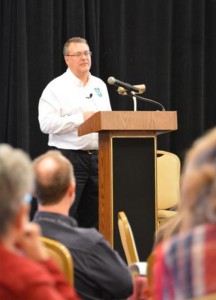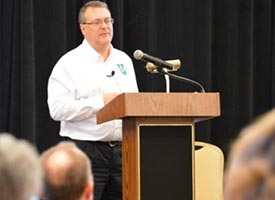By Adriane Heins
KANSAS CITY, Mo. — Farming. Faith. Finances. These were the at the core of conversations in the hallways and conference rooms of the 2014 LCMS Rural and Small-Town Mission (RSTM) conference here Nov. 6-8, as pastors and laypeople met to ask questions and solve problems specific to those areas.

They’re conversations worth having, since “rural and small-town folks make up 50 percent of LCMS membership,” noted the Rev. Todd Kollbaum, director of RSTM. “Over 50 percent of new seminarians go to rural parishes.”
This isn’t a new phenomenon. Many of those congregations have long histories in the LCMS.
“The small church has been the backbone of the Church in America from its inception and continues to be so today,” explained the Rev. Dr. Lawrence R. Rast Jr., president of Concordia Theological Seminary, Fort Wayne, Ind.
But those rural parishes bear their own unique set of blessings and challenges: everything from languishing (or burgeoning) bank accounts, to inactive members, to filling pulpits in small and remote parishes.
Where to begin? “There is no better way for us to do this mission than to be constantly and consistently in the Word of God,” encouraged Kollbaum. “We can embrace change … because we have the things that are unchangeable: God’s Word and Sacrament.”
Blessings and challenges
Stewardship ranks high among rural concerns, where some churches struggle to pay their bills while others sit comfortably on well-padded bank accounts. Starting with a correct understanding of “vocations or holy callings from God,” explained the Rev. Heath Curtis, coordinator for LCMS Stewardship, can change how members think of the gifts God gives, with regard to finances.
“What God has given you,” Curtis told attendees, “He’s given you for His purposes. It’s already earmarked — for home, for church, for society.”
Congregations, then, can begin to understand their financial situation when they encourage one another, Curtis explained, “to godly living and confidence in Christ.
Another concern? Identifying and caring for inactive members, visible in small communities but absent from the life of the local congregation. “Are those who are absent from worship hurting?” asked the Rev. Dr. Lee Hagan, pastor of St. Paul’s Lutheran Church, Concordia, Mo. “Every one of them is. … And when one member of the body hurts, the entire body hurts.”
Reminding attendees that it’s a congregation and pastor’s privilege to care for those inactive members, Hagan encouraged, “Preach the Word. Administer the Sacraments. Care for the flock. But show concern for each part of the body of Christ, not just those who are present but those who have strayed for whatever reason.”
One of those reasons might also include same-sex attraction. The Rev. Gary Zieroth, a member of the Synod’s “God’s Gift of Sexuality” task force, reminded pastors and laypeople alike that “if we as Christians, as Lutherans, believe that the Gospel is the power of God unto salvation, we believe change is possible.”
Encouraging care for those who struggle, Zieroth noted that the Church has the unique blessing of “reminding that person of their baptismal identity in Christ.”
“The media and the homosexual community want to deny that people can change,” he said, “but the Gospel has the power to do that.”
Ultimately, reaching out with the forgiving and comforting Gospel of Christ in rural settings can be a challenge, but the Rev. Dr. Dale Meyer, president of Concordia Seminary, St. Louis, encouraged attendees to see their setting as a blessing.
“Did you know that around 60 percent of the people in our rural and small-town communities are unchurched?” Meyer asked. “While we sometimes think of the mission field as ‘over there,’ there is a big mission field right outside our door.”
The Church is Christ’s
Spending time with other pastors and laypeople who live, work and care for one another in rural settings is a good practice, said the Rev. Andy Kennell, pastor of Our Redeemer Lutheran Church, Staplehurt, Neb. (population: 242).
“It reminds me that people who live in the community and who have lived there for a long time and … been disconnected from Jesus — that it’s important to continue to meet them with the Good News,” he said. “In rural and small-town mission work, you get into patterns. And they’re long patterns, going back generations — from children, to parents, to grandparents, who have all been disconnected from the Church.”
“Conferences like this remind us that if God can break and hinder every plan and purpose of the devil, He can break the sinful generational patterns of people who have been away. Our God is gracious and compassionate, slow to anger and abounding in love,” Kennell explained. “The Gospel is the power of God to save all who believe, and God is able to do immeasurably more than all we ask or imagine. That’s what’s fun to talk about and to share and to be a part of.”
And Kennell isn’t alone. “The Church, in the end, is Christ’s,” noted Rast, paraphrasing C.F.W. Walther, “and He is the head. And all the parts of the body, both large and small, are necessary for the well-functioning of the body.”
“The small church … is as much the Church in its fullness as the big church,” he told the crowd. “The size is not the point. The point is that is where Christ is.”
So how does the LCMS respond to all those rural and small-town blessings and challenges?
Be “agile. Nimble. But above all, be committed to Christ and His work through Word and Sacrament in whatever community we find ourselves,” Rast said. “That’s the bottom line.”
Adriane Heins is managing editor of The Lutheran Witness.
Posted Nov. 14, 2014
